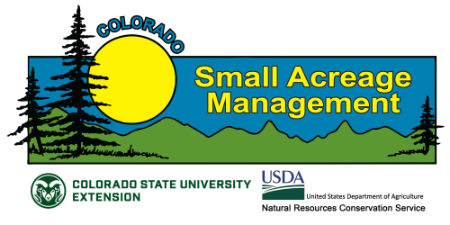Water
Water is a limited resource in many places in Colorado. It is important to understand how we can protect water quality and minimize our water quantity uses.
Drought updates for 2023
Off to a promising start… but what should you expect for this year’s drought forecast
Winter of 2023 up until the end of February has been a pretty cold and wet winter. As of March 5, snowpack state wade is 122% of the last 30 years median. Although these numbers seem promising snowfall for the next couple months is critical to have a better forecast of water availability for the rest of the spring and summer of 2023.
Most regions of Colorado seem to be entering the spring with moist soils than the past several years, which means, as temperatures start to warm and snow melts, that precipitation from the snow is more likely to supply rivers and sources of water, rather than being soaked by the soils.. This winter has brought most regions of the state an exceptional amount of snowpack to increase water supply in Colorado, especially on the western region. As of March 5, snowpack statewide is 122% of the median for the last 30 years. This is great news! – For now. Although precipitation has been high enough to supply enough moisture to Colorado’s soil, it is still early in the season to determine what the spring and summer will look like.
The best is yet to come?
Colorado’s wet season peaks from late February to the start of the spring and has a much greater impact on drought conditions, so the next few weeks of winter are more likely to set the stage for what moisture will look like for the spring and summer. Regardless of what these upcoming weeks look like, dryland most likely will benefit, at least partially from the high precipitation Colorado has received until now, but experts recommend to remain water conscious throughout the year, as many years of “good” winters are required to lower the guard on drought for Colorado.
For more information and up-to date data on drought monitoring throughout the country, visit: https://droughtmonitor.unl.edu/Data.aspx
Water Quantity
Colorado has a semi-arid climate and water is a very limited resource in many places. The average yearly precipitation in Colorado is 17 inches. However, the San Luis Valley and parts of south central Colorado receive an average of less than 12 inches of precipitation each year and many mountainous regions receive an average of 40 inches of precipitation or more each year. Do you know how much precipitation your area receives?
In addition to climate limitations, water regulations may also determine the amount of water you have available to use at a given time. Know your water rights. For example, if a ditch flows through your property, you may not have the right to use the water. Know what water uses your well is permitted for. Many rural wells are designated household-use-only which means water can be used only within the home, with no outside watering, including gardens and livestock uses. Contact the Colorado Division of Water Resources to find out what your water rights are.
How can I conserve water on my property?
- Rainwater Collection in Colorado – Colorado residents can now legally collect up to 110 gallons of rain for outdoor use.
- Irrigation Scheduling: The Water Balance Approach
- Irrigation for Small Acreages – how to do a small acreage irrigation audit for furrow and side-roll sprinkler
- Lawn Irrigation Self Audit (LISA) – contains videos and instruction on how to save energy and water by adjusting your irrigation system
- Rainwater Reuse and Rainwater Harvesting
- Rainwater Harvesting – Senate bill recently passed
- SARE Smart Water Use
- Save water with efficient irrigation systems and low water use plants, NRCS Water Conservation Tip sheet
- Taking Care of Your Groundwater DVD – Mountain and Plains Regional Water Project produced through Montana State University
- Water Conservation In and Around the Home
- Xeriscaping
- Xeriscaping: Trees and Shrubs
Water Quality
Because water is such a limited resource in Colorado, we need to protect the quality of our water.
Many potential sources of pollution exist around a typical home or farm that may impact water quality.
How Can I Prevent Water Pollution?
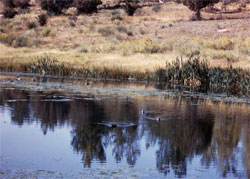
- Protect Riparian Areas:
- Create or maintain a Riparian Buffer at least 50 feet to 250 feet from the water’s edge
- Allow very limited or no grazing within the buffer to maintain healthy vegetation
- Plant native trees, shrubs, and grasses in the buffer area
- Avoid storing manure or corralling animals within the buffer area
- Use only water-safe herbicides within the buffer area
- Find out how much water your plants and/or crops need to avoid over-irrigating. Over-irrigating leaches soil nutrients, causes erosion, and spreads fertilizer and pesticides.
- Dispose of manure, bedding, and feed wastes by composting, spreading on crops, or hauling it to a composting or disposal facility.
- Read fertilizer, herbicide, and pesticide labels carefully and only use the recommended amounts.
- Properly store and dispose of chemicals, used motor oil, and other toxic substances. Contact your county health department for local toxic substance disposal info.
Why is it important to protect wetlands and areas along a stream?
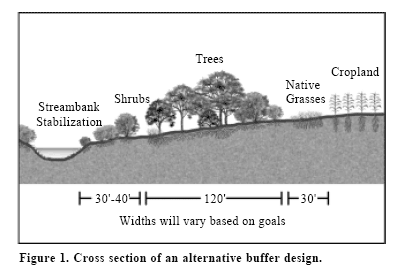
A Riparian Area is the area adjacent to a surface water body. Riparian vegetation can function as a natural filter for contaminates that can runoff from surrounding areas. We can protect stream water quality by maintaining a vegetative buffer of 50 feet to 250 feet from the water’s edge. Within the riparian buffer, limit or discontinue grazing to maintain a healthy stand of vegetation. To protect water from excess nutrients and sedimentation, do not allow animal access to streams, ponds, or other water bodies.
Flood Recovery
Flood Recovery Resources
The most up-to-date flood-related resources to help deal with flooding and flood-related issues. Learn more
Flooded Wells Need Tested
Whenever flooding occurs, there’s likely to be some compromised water supplies at the municipal and private scale. Flooded wells need testing and possibly chlorination, and there are some who are needing to look at alternative water supplies.
If you are dealing with the situation, here are some resources:
Drinking Water Resources – video clips linkedthat describe how to chlorinate a well, well and septic educational videos, and water quality tools
Wells and Septic
Septic Systems and Well Basics
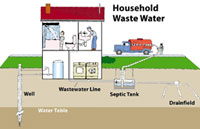
- Septic Do’s and Don’ts
- Septic System Guidelines
- Water Well Guidelines
- Drinking Water Resources – well and septic educational videos, and water quality tools
Is my well water at risk of contamination?
Take the self-assessment to find out.
| Private Well Protection Checklist | Yes | No |
| • Have you had your well water tested within the last two years? | ||
| • Is your well less than 20 years old? | ||
| • Is the water table around your well deeper than 30 feet? | ||
| • Is your well securely capped and does it have intact casing that extends 1 foot above ground level? | ||
| • Is your well properly grouted to prevent entry of surface water? | ||
| • Do you mix, load, or store pesticides or fertilizer at least 100 feet from the well? | ||
| • Do you have backflow prevention devices installed on all faucets used to fill spray tanks? | ||
| • Are animal corrals and lagoons located at least 100 feet downhill from the well? | ||
| • Is your septic tank at least 50 feet from the well? | ||
| • Have you had your septic system pumped within the last four years? | ||
| • Are unused wells on your property properly plugged, sealed and abandoned according to the Construction Rules (2 CCR 402-2)? | ||
| • Are underground storage tanks removed or less than 10 years old? | ||
| • Are all fuel tanks at least 100 feet from the well? | ||
| • Do you dispose of pesticide containers, solvents, lubricants, paints, household cleaning products, and old batteries properly off-site? | ||
| If you answer No to any of these questions, your well may be vulnerable to contamination.
Consider having your water tested and evaluate how you can improve the safety of your water supply. For more information refer to Protecting Your Private Well. |
||
Irrigation
Small Acreage Irrigation Guide
 This guide provides information about water rights and irrigation for small acreage landowners. While the content is largely directed towards those engaged or interested in some form of agricultural production, it may also be useful for those simply interested in maintaining their yard and garden plot. This guide addresses many important questions about water rights and water use for landowners and for those thinking of purchasing land. Crop water needs and irrigation scheduling are discussed, and examples are provided to help the user with common calculations necessary for irrigation scheduling and ordering the necessary amount of water to meet crop needs. In addition, information is provided on irrigation systems that are appropriate for 5 acres or less, including pumps, pipelines, and water application options. Download guide.
This guide provides information about water rights and irrigation for small acreage landowners. While the content is largely directed towards those engaged or interested in some form of agricultural production, it may also be useful for those simply interested in maintaining their yard and garden plot. This guide addresses many important questions about water rights and water use for landowners and for those thinking of purchasing land. Crop water needs and irrigation scheduling are discussed, and examples are provided to help the user with common calculations necessary for irrigation scheduling and ordering the necessary amount of water to meet crop needs. In addition, information is provided on irrigation systems that are appropriate for 5 acres or less, including pumps, pipelines, and water application options. Download guide.
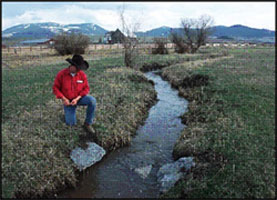
Irrigation Water Quality
Do you know the quality of your domestic, irrigation, and livestock water supply? The CSU Soil, Water, and Plant Testing Lab can test your water. Components of water which can affect your crops and plants are pH, salt, sodium, nitrogen, boron, sulfate, and chloride. Refer to the CSU factsheet, Irrigation Water Quality Criteria for more information.
Irrigation Resources
- Irrigation Scheduling: The Water Balance Approach
- Irrigation for Small Acreages – how to do a small acreage irrigation audit for furrow and side-roll sprinkler
- Landowners Guide to Incorporating Irrigation Ditches and Laterals – Sponsored by the US Bureau of Reclamation
- Lawn Irrigation Self Audit (LISA) – contains videos and instruction on how to save energy and water by adjusting your irrigation system
- Save water with efficient irrigation systems and low water use plants, NRCS Water Conservation Tip sheet
- SARE Smart Water Use
Resources
Resources & Helpful Information
SAM Webinars and Web Videos
- Water Wells & Oil/Gas Reserves in Northeastern Colorado
- Assessing Your Small Acreage for Water Quality and Environmental Protection
- WaterWise Landscapes on Small Acreages
- Colorado Water 101 for Small Acreage Landowners
- Understanding Colorado Drought
- Water Etiquette in Colorado During a Drought Year
- Septic System and Well Basics
- Planning for a Sustainable Homestead
- Water Wells & Oil/Gas Reserves in Northeastern Colorado
- Assessing Your Small Acreage for Water Quality and Environmental Protection
- Septic System and Well Basics
SAM Newsletter Articles
- Basic Drip Irrigation Planning and Design – spring 2018
- Low Water Native Plant Guides – winter 2018
- Colorado Water History – spring 2013
- Protecting and Enhancing Riparian Areas – fall 2012
- Maintaining Water Quality – spring 2010
- Colorado Snow Survey Program – spring – 2010
- Big Gun Irrigation Can Increase Hay Production – spring 2017
- Irrigation Options: Side Roll Sprinklers – fall 2016
- Rainwater Collection Bill – summer 2016
- Gated Pipe – spring 2016
- Introducing LISA: A Smarter Way to Irrigate Your – winter 2016
